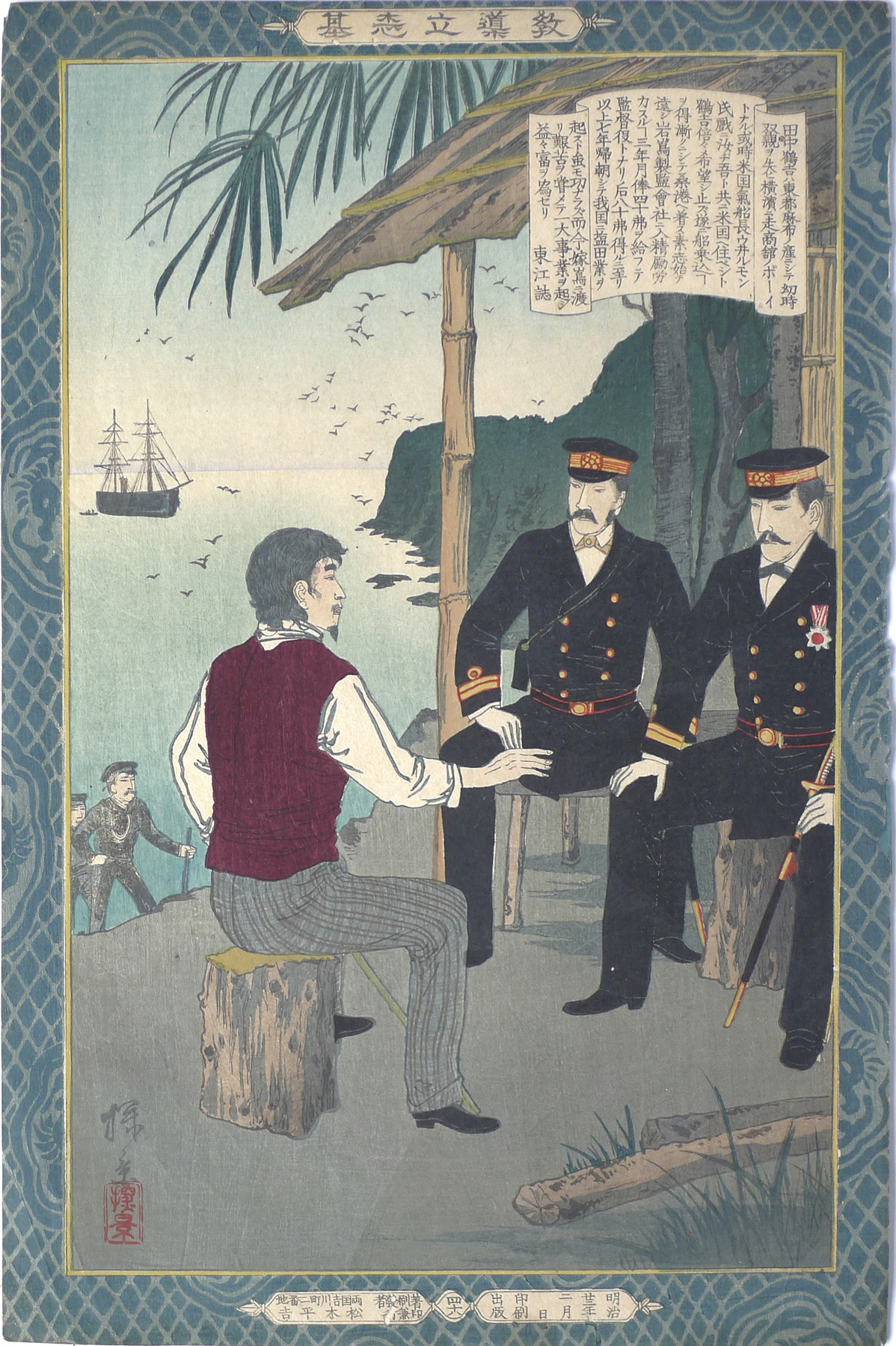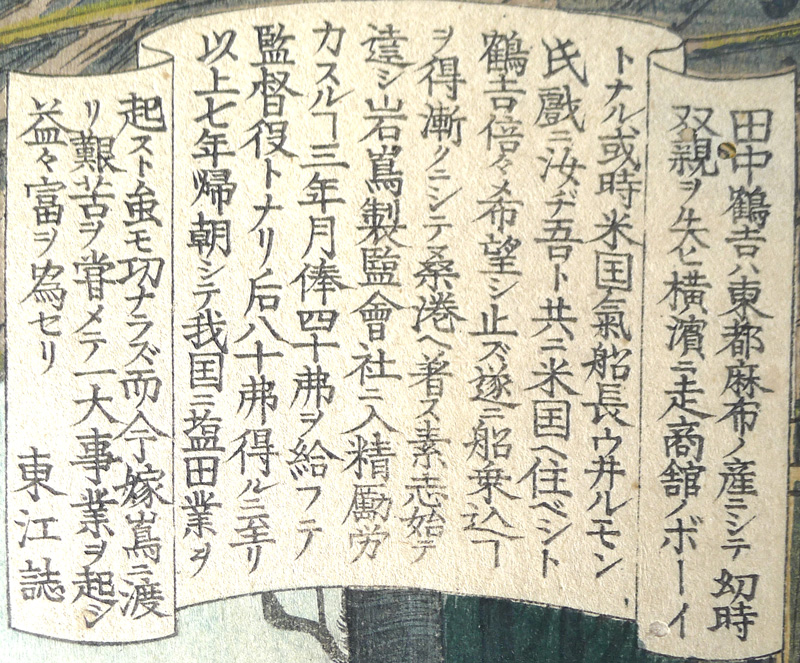About This Print
Print number 48 (四十八)1 in the series Instructive Models of Lofty Ambition picturing the adventurer Tanaka Tsurukichi (1855-1925), known as the "Japanese Robinson Crusoe", speaking with Japanese naval officers. Tanaka traveled to the United States at an early age, possibly as young as 12, returned to Japan in 1881, and, finally, emigrated to the US in 1887. While this design was created after Tanaka's return to live in the United States, its setting appears to be on the Boshin Islands, where Tanaka established a less than successful stock farm.2Inoue, a student of Kobayashi Kiyochika, contributed thirteen prints to the series. He was to die at the age of 25 in 1889, the year this print was issued.
1 Numbering of the prints was haphazard during the production of the series. Print numbers were sometimes inadvertently omitted; some prints in the series were never assigned numbers and a few of the same numbers appear on different prints.
2 According to the September 25, 1886 edition of The Japan Weekly Mail "The much talked of stock-farm of Mr. Tanaka Tsurukichi, popularly called the Robinson Crusoe of the east...supports only about 800 pigs and 15 head of cattle. The sheep sold to Mr. Tanaka by the Japanese Government have all perished.... The few student agriculturalists who were induced...to join Mr. Tanaka, are reported...to be regretting their rash conduct."
The Story of Tanaka Tsurukichi, the "Japanese Robinson Crusoe"
The story of Tanaka Tsurukichi is told in The Tale of the Castaway of the Self-Made Man Tanaka Tsurukichi (出世の鏡 忍耐起業 田中鶴吉伝) by Ichikawa Hanjirō (石川半次郎 ), published in 18871. English language information on Tanaka's first visit to America is somewhat muddled, with some sources stating that he stowed-away to San Francisco while others stating he traveled as a cabin boy. Also, the age of his first departure, whether at 12 or five or six years later, is somewhat in doubt. We do know that he first worked as a servant in San Francisco and later in a salt mine in California, returning to Japan around 1881 to start various unsuccessful enterprises, including the above-mentioned stock farm and later a salt mine. His real success came with his 1887 return to the United States where he set up several successful businesses allowing him to bring both his wife and mother to live with him.His life was seen a tale of perseverance.
1 The full text of this book can be found at http://kindai.ndl.go.jp/info:ndljp/pid/781674
Transcription of Scroll
A scroll, present on each print in the series, contains brief historical details of the figure and scene being portrayed.
click on scroll to enlarge
Note: The National Library of Australia's notes for this print state that while the scroll says that Tanaka's Japanese salt farm was going well, it did not succeed.
Source: with thanks to Yajifun http://yajifun.tumblr.com/
48 Tanaka Tsurukichi 田中鶴吉
教導立志基 四十八 田中鶴吉 井上探景(安治) 1889年4月
Transcription:
“田中鶴吉ハ東都麻布ノ産ニシテ幼児双親ヲ失ヒ横濱(横浜)ニ走 商館ノボーイトナル 或時米国氣船長(汽船長)ウヰルモン氏 戲(戯)ニ汝ヂ吾ト共ニ米国ヘ住ベシト 鶴吉倍々希望シ止ズ遂ニ船乗込コトヲ得 漸クニシテ桑港ヘ着ス素志始テ達シ岩嶋製鹽會社(製塩会社)ニ入 精勵(精励)労力スルコト三年 月俸四十弗ヲ給フテ監督役トナリ后八十弗得ルニ至リ以上七年 帰朝シテ我国ニ塩田業ヲ起スト?(イヘド)モ功ナラズ而今嫁嶋ニ渡リ艱苦ヲ甞メテ一大事業ヲ起シ益々富ヲ為セリ 東江 誌”
About The Series "Kyōdō risshi no motoi"
Notes:1. This series is variously translated as "Instructive Models of Lofty Ambition," "Foundations of Learning and Achievement," "Foundation of Instruction and Perseverance," "Self-Made Men Worthy of Emulation," "Paragons of Instruction and Success," "Moral of Success," "Examples of Self-Made Leaders," and "Instruction in the Fundamentals of Success." The title in Japanese is sometimes seen as "Kyōdō risshiki or "Kyōdō risshi no moto," in addition to the most commonly seen transliteration of "Kyōdō risshi no motoi".2. For a complete listing of all the prints in the series and additional information please see the article on this site titled Instructive Models of Lofty Ambition.
This series ran between October 1885 and November 1890 and featured a long list of heroes and heroines, from antiquity to contemporary times, who were regarded as standards of moral leadership and self-realization.
Source: Kiyochika Artist of Meiji Japan, Henry D. Smith II, Santa Barbara Museum of Art, 1988, p. 74-75; original research and as footnoted.
This series of 58 prints,1 plus a table of contents sheet (目録), were originally published between October 1885 and November 1890 by the Tokyo publisher Matsuki Heikichi 松木平吉.2 The table of contents sheet issued by the publisher states that "fifty prints make up the complete set (五十番揃)". Three prints not in the initial release were added over the five year publication period, as were five redesigns of original prints, eventually increasing the total print count to 58. The seven artists contributing prints were Kobayashi Kiyochika (1847-1915) [20 prints], Mizuno Toshikata (1866-1908) [16 prints], Inoue Tankei (Yasuji) (1864-1889) [13 prints], Taiso (Tsukioka) Yoshitoshi (1839-1892) [5 prints], Yōshū Chikanobu (1838-1912) [2 prints], Toyohara Kunichika (1835–1900) [1 print], and Hachisuka (Utagawa) Kuniaki II (1835-1888) [1 print]. All the artists, with the exception of Yōshū Chikanobu, are listed in the top scroll of the table of contents sheet. Various colors (including blue, blue/green, and tan/brown) were used for the decorative border, and in 1902 the series was re-issued by Matsuki without borders.
Brief texts contained within a scroll-like cartouche appearing on each print provide historical details. The scroll composer's name is given at the end of the scroll text. The “lofty ambition” of the title is a Confucian concept, originally from Mencius, meaning “righteous determination that would inspire others.” The market for the series probably included former samurai, ambitious youth, and conservative intellectuals.
"[W]hen it was completed in 1890 the publisher was singled out for special recognition by the government for having sponsored such noble subject matter."3
This series ran between October 1885 and November 1890 and featured a long list of heroes and heroines, from antiquity to contemporary times, who were regarded as standards of moral leadership and self-realization.
Source: Kiyochika Artist of Meiji Japan, Henry D. Smith II, Santa Barbara Museum of Art, 1988, p. 74-75; original research and as footnoted.
This series of 58 prints,1 plus a table of contents sheet (目録), were originally published between October 1885 and November 1890 by the Tokyo publisher Matsuki Heikichi 松木平吉.2 The table of contents sheet issued by the publisher states that "fifty prints make up the complete set (五十番揃)". Three prints not in the initial release were added over the five year publication period, as were five redesigns of original prints, eventually increasing the total print count to 58. The seven artists contributing prints were Kobayashi Kiyochika (1847-1915) [20 prints], Mizuno Toshikata (1866-1908) [16 prints], Inoue Tankei (Yasuji) (1864-1889) [13 prints], Taiso (Tsukioka) Yoshitoshi (1839-1892) [5 prints], Yōshū Chikanobu (1838-1912) [2 prints], Toyohara Kunichika (1835–1900) [1 print], and Hachisuka (Utagawa) Kuniaki II (1835-1888) [1 print]. All the artists, with the exception of Yōshū Chikanobu, are listed in the top scroll of the table of contents sheet. Various colors (including blue, blue/green, and tan/brown) were used for the decorative border, and in 1902 the series was re-issued by Matsuki without borders.
This series of 58 prints,1 plus a table of contents sheet (目録), were originally published between October 1885 and November 1890 by the Tokyo publisher Matsuki Heikichi 松木平吉.2 The table of contents sheet issued by the publisher states that "fifty prints make up the complete set (五十番揃)". Three prints not in the initial release were added over the five year publication period, as were five redesigns of original prints, eventually increasing the total print count to 58. The seven artists contributing prints were Kobayashi Kiyochika (1847-1915) [20 prints], Mizuno Toshikata (1866-1908) [16 prints], Inoue Tankei (Yasuji) (1864-1889) [13 prints], Taiso (Tsukioka) Yoshitoshi (1839-1892) [5 prints], Yōshū Chikanobu (1838-1912) [2 prints], Toyohara Kunichika (1835–1900) [1 print], and Hachisuka (Utagawa) Kuniaki II (1835-1888) [1 print]. All the artists, with the exception of Yōshū Chikanobu, are listed in the top scroll of the table of contents sheet. Various colors (including blue, blue/green, and tan/brown) were used for the decorative border, and in 1902 the series was re-issued by Matsuki without borders.
Brief texts contained within a scroll-like cartouche appearing on each print provide historical details. The scroll composer's name is given at the end of the scroll text. The “lofty ambition” of the title is a Confucian concept, originally from Mencius, meaning “righteous determination that would inspire others.” The market for the series probably included former samurai, ambitious youth, and conservative intellectuals.
"[W]hen it was completed in 1890 the publisher was singled out for special recognition by the government for having sponsored such noble subject matter."3
1 The Tokyo Metropolitan Library online collection shows 50 prints and a Table of Contents sheet. The Table of Contents lists the titles of 50 prints. Smith in Kiyochika Artist of Meiji Japan identified 52 prints. I have identified 58 prints from this series including five prints (Ikina, Michizane Sugiwara, Kesa Gozen, Soga Brothers and Hokiichi Hanawa) that were re-designed and re-printed, likely due to damaged or lost blocks.
2 Robert Schaap notes in Appendix II, p. 166 of Yoshitoshi, Masterpieces from the Ed Freis Collection, Chris Uhlenbeck and Amy Reigle Newland, Hotei Publishing, 2011 that the series originally appeared as newspaper supplements.
3 The World of the Meiji Print: Impressions of a New Civilization, Julia Meech-Pekarik, Weatherhill, 1986, p. 122.
1 The Tokyo Metropolitan Library online collection shows 50 prints and a Table of Contents sheet. The Table of Contents lists the titles of 50 prints. Smith in Kiyochika Artist of Meiji Japan identified 52 prints. I have identified 58 prints from this series including five prints (Ikina, Michizane Sugiwara, Kesa Gozen, Soga Brothers and Hokiichi Hanawa) that were re-designed and re-printed, likely due to damaged or lost blocks.
2 Robert Schaap notes in Appendix II, p. 166 of Yoshitoshi, Masterpieces from the Ed Freis Collection, Chris Uhlenbeck and Amy Reigle Newland, Hotei Publishing, 2011 that the series originally appeared as newspaper supplements.
3 The World of the Meiji Print: Impressions of a New Civilization, Julia Meech-Pekarik, Weatherhill, 1986, p. 122.
Print Details
| IHL Catalog | #758 |
| Title or Description | Tanaka Tsurukichi 田中鶴吉 |
| Series | “Instructive Models of Lofty Ambition” (Kyodo risshiki 教導立志基) [note: seriestitle also listed as 'Kyodo Risshi no Moto', ‘Kyodo risshi no motoi’,‘Kyōdō risshi ki’ and variously translated as “Moral of success” or“Foundations of learning and achievement” or “Self-made Men Worthy ofEmulation”' or “Examples of Self-made Leaders” or "Paragons of instruction and success"] |
| Artist | Inoue Yasuji (1864-1889) |
| Signature |  |
| Seal |  |
| Publication Date | February 1889 明治廿二年 二月 |
| Publisher | Matsuki Heikichi (松木平吉) proprietor of Daikokuya Heikichi [Marks: seal not shown; pub. ref. 029] (from right to left) publishing and printing date: 明治廿二年 二月 日 印刷 出版 [notification delivered, Meiji 22nd year 2nd month day] assigned number within series: 四十八 [48] publisher information: 著刷發者 両国吉川町二番地 印兼行 松木平吉 [publisher and printer Ryōgoku Yoshikawachō 2-banchi Matsuki Heikichi] |
| Impression | excellent |
| Colors | excellent |
| Condition | fair - trimmed to image; ragged right border; numerous small tears and wormholes repaired on verso; remnants of former backing |
| Genre | ukiyo-e; rishki-e; kyōiku nishiki-e |
| Miscellaneous | print number 48 (四十八); position 49 in the Table of Contents for the series |
| Format | vertical oban |
| H x W Paper | 13 7/8 x 9 1/4 in. (35.2 x 23.5 cm) |
| Literature | |
| Collections This Print | Museum of Fine Arts, Boston 63.783; National Library of Australia 5009199; Tokyo Metropolitan Library 280-K25 |



